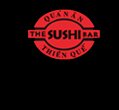What is Sushi?
How to Eat SUSHI
1 .Enjoy the various beautiful colors of the NETA (fishs lices/ingredients) first. (Visualize tasting sushi with your eyes.)
2 .Place soy sauce for dipping in a small dish.
3 .Mix a bit of WASABI(Japanese horseradish) with the soy sauce, or place a bit of wasabion the neta if you want.
4. Pick up one piece of sushi with your thumb, index finger, and middle finger. Or you can choose to use chopsticks.
5. Dip just the tip of the neta in some soysauce.Turn the sushi over and bring it to your mouth.
6. Place the whole sushi piece in your mouth if possible.
7. Close your eyes and enjoy the taste.
The history of SUSHI
We can trace sushi’s origin back to the 4th century BC in Southeast Asia. As a preserved food, the salted fish, fermented with rice, was an important source of protein. The cleaned and gutted fish were kept in rice so that the natural fermentation of the rice helped preserve the fish. This type of sushi is called nare-zushi, and was taken out of storage after a couple of months of fermentation, and then only the fish was consumed while the rice was discarded.
Over time, it spread throughout China, and later, around the 8th century AD, in the Heian period, it was introduced into Japan. Since Japanese preferred to eat rice together with fish, the sushi, called seisei-zushi, became popular at the end of Muromachi period. This type of sushi was consumed while the fish was still partly raw and the rice had not lost its flavor. In this way, sushi became more of a cuisine rather than a way to preserve food.
Later in Edo era, Japanese began making haya-zushi, which was created as a way to eat both rice and fish; this dish was unique to Japanese culture. Instead of being only used for fermentation, rice was mixed with vinegar and combined not only with fish but also with various vegetables and dried preserved foods. Today, each region of Japan still preserves its own unique taste by utilizing local products in making different kinds of sushi that have been passed on for generations.
At the beginning of the19th century, when Tokyo was still called Edo, the food service industry was mostly dominated by mobile food stalls, from which nigiri-zushi originated. Edomae, which literally means “in front of Tokyo bay,” was where the fresh fish and tasty seaweed for the nigiri-zushi were obtained. As a result, it was also called edomae-zushi, and it became popular among the people in Edo after Yohei Hanaya, a creative sushi chief, improved it to a simple but delicious food. Then, after the Great Kanto earthquake in 1923, nigiri sushi spread throughout Japan as the skilled edomae-zushi chefs from Edo, who had lost their jobs, were diffused all over Japan.
In the 1980s, in the wake of increased health consciousness, sushi, one of the healthiest meals around, has gotten much more attention; consequently, sushi bars have increased in the United States. With the introduction of sushi machines, which combines the mass production of sushi with the delicate skills used by sushi chefs, making and selling sushi has become more accessible to countries all over the world.
SUSHI Vocabulary
- Arigato – Thank you.
- Chakin-zushi – Vinegared rice wrapped in a thin egg crepe.
- Chirashi(-zushi) – Assorted raw fish and vegetables over rice.
- Domo (DOH moh) – Thank you.
- Edomae-zushi – Same as nigiri-zushi.
- Gari – Vinegared ginger.
- Gyoku – Tamago.
- Hashi – Chopsticks.
- Inari-zushi – Vinegared rice and vegetables wrapped in a bag of fried tofu.
- Itamae-san – The Sushi Chef.
- Kanpai – The Japanese equivalent of “cheers,” used when drinking
- Konbanwa – Good evening.
- Murasaki – Soy sauce.
- Namida – Wasabi.
- Neta – Sushi topping.
- Nigiri(-zushi) – Pieces of raw fish over vinegared rice balls.
- Nori – The sea vegetable used with rolled sushi.
- Oaiso – The check.
- Okanjo – The check.
- Oshibori – Rolled up hot towel served to sushi bar customers.
- Oshinko- Japanese pickles.
- Oyasumi nasai – Good night.
- Sabinuki – No wasabi.
- Sashimi – Raw fish served chilled, sliced, and arranged without rice.
- Shamoji – Sushi rice paddle.
- Shari – Vinegared rice ball.
- Shoyu – Soy sauce.
- Sumimasen – Excuse me.
- -tataki – Pounded, almost raw fish.
- Tekka-don – Pieces of raw tuna over rice.
- Uchiwa – Fan, used for fanning sushi rice.
- Wasabi – Japanese horseradish.










